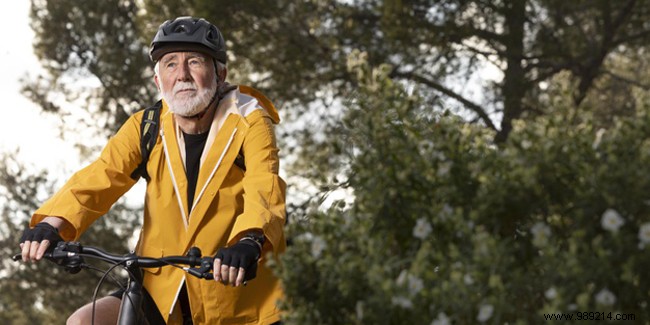
Practicing a physical activity when you are a senior, as we know and all health professionals say, is essential to maintain your shape, avoid the onset of illnesses, and keep your spirits up! Not all sports are recommended with age, but cycling is one of those quite accessible to seniors. This sport is in fact suitable even for people who suffer from joint problems and it represents an excellent cardiovascular exercise. Be careful though, cycling requires respecting certain safety rules, especially when you are a senior. Our advice for practicing cycling without taking risks.
Before venturing into town or the countryside on a bicycle, the first safety precaution to take is to choose a suitable bicycle. First of all, it is important to feel good on your bike, to be comfortably seated in the saddle, and to use a machine that is the perfect size and that is not too heavy in particular.
Then, to ride safely, a bike must be in good condition and well equipped. Thus, certain equipment is mandatory:a bell that must be heard at least 50 meters away and brakes in good condition.
Even if other equipment is not mandatory, if you ride in town, it is strongly recommended to equip your bike with a spacer, equipment that encourages vehicles to move well away from you when they overtake you.
In the same way, equipping your bike with a mirror can be very useful, especially for seniors who have more problems moving around easily.
Finally, if you have to ride at night or when the light is poor, it is very important to be perfectly lit. This is why it is compulsory to equip your bike with these lights:an orange or white front light, a front white reflector, a rear red light and a red reflector; reflectors fixed in the wheels or reflective strips on each tire; and reflectors on the pedals.
Even on a bike, the Highway Code applies! Far too many cyclists forget this and thus risk their lives on the road.
Like all users of the public road, it is for example imperative to stop at red lights, even on a bicycle. Nevertheless, the Highway Code now authorizes certain red lights to be crossed by people on bicycles provided that a specific sign authorizes them to do so.
A good reason, especially for seniors who obtained their driving license a long time ago, to review the rules of the Highway Code which have been modified in particular with the growing use of bicycles. To do this, the French Cycling Federation has French Cycling Schools where it is possible to review, or learn, the safety rules when traveling by bike.
Other safety rules are essential when cycling, such as putting your foot down to mark a stop, not riding in the wrong direction unless specific signage provides for it, such as in the "30 km zones". /h” where the two-way traffic is possible for cyclists, or even the prohibition for bicycles to ride on sidewalks.
In addition to the compulsory lighting equipment, certain measures must be adopted to be seen clearly by other road users, and therefore to travel by bicycle in complete safety.
It is important, for example, to wear light-coloured clothing when cycling, especially in low light. It is also best to adapt reflective accessories to your clothing. For example, there are reflective bracelets on the market that you can wear on your arms, ankles, or gloves and shoes equipped in the same way. Putting on a high visibility vest (yellow vest) is also a guarantee of riding a bike in complete safety and being seen on the road.
On the other hand, one of the dangers of the road, and even more so on a bicycle, is the blind spot, that is to say the space that is not visible around you. This blind spot is responsible for the majority of bicycle accidents. Caution is therefore in order and always requires being very focused on your environment when traveling by bike. Pay particular attention to trucks in this regard.
With the development of cycling, more and more municipalities have cycle paths reserved for cyclists, for better safety.
These cycle paths, when they exist, are compulsory for bicycles and they are the subject of specific road signs.
If you ride in an area without cycle paths, you must follow certain rules to guarantee your safety:always ride on the right side of the road and, to avoid falls, do not ride too close to gutters.
In any case, on a bike, it is essential to signal to other users, and to anticipate, all your changes of direction by extending your arm throughout your maneuver.
On the other hand, if you want to use the pedestrian crossings with your bike, you must put your feet on the ground unless there is a special bike lane, usually marked with small circles on the roadway.
Wearing a helmet when riding a bicycle is compulsory for all children under 12 years old. But, even if this obligation does not concern adults, it is prudent, especially for seniors less comfortable on a bike, to always wear a helmet, adapted and above all well adjusted on his head. The latter is in fact the only protection that prevents serious trauma to the skull in the event of a fall or accident.